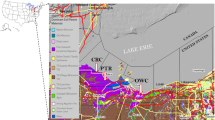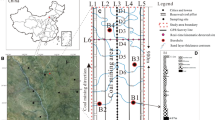Abstract
The active layer thickness (ALT) is a key parameter for permafrost studies. Changes in the ALT are affected mainly by air and ground temperatures, physical and thermal properties of the surface and subsurface materials, soil moisture, vegetation, and the duration and thickness of snow cover. Ground penetrating radar (GPR) and electrical resistivity tomography (ERT) were employed across a snow fence during the thawing season to delineate and monitor the active layer of permafrost in Cambridge Bay, Nunavut, Canada. The variation of the ALT is well captured by the high-resolution time-lapse radargram. At the position of the fence, the active layer thickens over the thawing period from 0.5 m depth at the beginning to 1.0 m depth at the end. The active layer is thicker in the pre-fence area (C zone) than in the post-fence area (H zone). As the air temperature increases with time, the difference in thickness between the two zones decreases, eventually becoming almost equal. Changes in the ALT are represented in the ERT by low resistivities (< 200 Ωm), which decrease gradually with time. This occurs most significantly in the H zone due to the rapidly increasing temperature in the absence of snow cover. The electrical resistivity structure of the active layer is well correlated with the vegetation activity, as measured by the normalized difference vegetation index, air/ground temperatures, soil moisture, snow cover, and snow accumulation controlled by the fence. Geophysical data interpretation and correlation schemes with vegetation and meteorological data explored in this paper can be applied to monitor the active layer, which is expected to thin during the freezing season.
Similar content being viewed by others
References
Barendregt, R.W., Vincent, J.S., Irving, E., and Baker, J., 1998, Magneto-stratigraphy of Quaternary and late Tertiary sediments on Banks Island, Canadian Arctic Archipelago. Canadian Journal of Earth Sciences, 35, 147–161.
Behmann, J., Acebron, K., Emin, D., Bennertz, A., Matsubara, S., Thomas, S., Bohnenkamp, D., Kuska, M.T., Jussila, J., Salo, H., Mahlein, A., and Rascher, U., 2018, Specim IQ: evaluation of a new, miniaturized handheld hyperspectral camera and its application for plant phenotyping and disease detection. Sensors, 18, 441.
Blanc-Betes, E., Welker, J.M., Sturchio, N.C., Chanton, J.P., and Gonzalez-Meler, M.A., 2016, Winter precipitation and snow accumulation drive the methane sink or source strength of Arctic tussock tundra. Global Change Biology, 22, 2818–2833.
Briggs, M.A., Campbell, S., Nolan, J., Walvoord, M.A., Ntarlagiannis, D., Day-Lewis, F.D., and Lane, J.W., 2017, Surface geophysical methods for characterising frozen ground in transitional permafrost landscapes. Permafrost and Periglacial Processes, 28, 52–65.
Brown, J., Ferrians Jr., O.J., Heginbottom, J.A., and Melnikov, E.S., 1997, Circum-Arctic map of permafrost and ground-ice conditions. Circum-Pacific Map 45, U.S. Geological Survey, Reston. https://doi.org/10.3133/cp45
Dolbinski, W., 2009, Geophysical methods in research of permafrost in the tetra mountains and northern Scandinavia. Landform Analysis, 10, 26–32.
Elmendorf, S.C., Henry, G.H.R., Hollister, R.D., Björk, R.G., Boulanger-Lapointe, N., Cooper, E.J., Cornelissen, J.H.C., Day, T.A., Dorrepaal, E., Elumeeva, T.G., Gill, M., Gould, W.A., Harte, J., Hik, D.S., Hofgaard, A., Johnson, D.R., Johnstone, J.F., Jónsdóttir, I.S., Jorgenson, J.C., Klanderud, K., Klein, J.A., Koh, S., Kudo, G., Lara, M., Lévesque, E., Magnússon, B., May, J.L., Mercado-Díaz J.A., Michelsen, A., Molau, U., Myers-Smith, I.H., Oberbauer, S.F., Onipchenko, V.G., Rixen, C., Martin Schmidt, N., Shaver, G.R., Spasojevic, M.J., Þórhallsdótir, E., Tolvanen, A., Troxler, T., Tweedie, C.E., Villareal, S., Wahren, C.-H., Walker, X., Webber, P.J., Welker, J.M., and Wipf, S., 2012, Plot-scale evidence of tundra vegetation change and links to recent summer warming. Nature Climate Change, 2, 453–457.
Erji, D., Lin, Z., Tonghua, W., Ren, L., Guangyang, Y., Xiaodong, W., Wangping, L., Yongliang, J., Guojie, H., Yongping, Q., Zhiwei, W., Defu, Z., and Guangyue, L., 2016, The relationship between the ground surface layer permittivity and active-layer thawing depth in a Qinghai-Tibetan Plateau permafrost area. Cold Regions Science and Technology, 126, 55–60.
Farzamian, M., Vieira, G., Santos, F.A.M., Tabar, B.Y., Hauck, C., Paz, M.C., Bernardo, I., Ramos, M., and Pablo, M.A., 2020, Detailed detection of active layer freeze-thaw dynamics using quasi-continuous electrical resistivity tomography (Deception Island, Antarctica). The Cryosphere, 14, 1105–1120.
Frédéric, B., Daniel, F., Michel, P., Vincent, B., Reinhard, P., and Isabelle, L., 2020, Thermokarst lake inception and development in syngenetic ice-wedge polygon terrain during a cooling climatic trend, Bylot Island (Nunavut), eastern Canadian Arctic. The Cryosphere, 14, 2607–2627.
Frédéric, B., Lauren, A.M., Kevin, W.T., Joshua, R.T., Andrew, S.M., Boris, K.B., Jennifer, K., Roland, I.H., Reinhard, P., and Brent, B.W., 2016, Paleolimnology of thermokarst lakes: a window into permafrost landscape evolution. Arctic Science, 3, 91–117.
Harris, S.A., French, H.M., Heginbottom, J.A., Johnston, G.H., Ladanyi, B., Sego, D.C., and van Everdingen, R.O., 1988, Glossary of permafrost and related ground-ice terms. Technical Memorandum No. ACGR-TM-142, National Research Council of Canada. Associate Committee on Geotechnical Research. Permafrost Subcommittee, Ottawa, 159 p. https://doi.org/10.4224/20386561
Harrison, J.C., Christie, R.L., Rainbird, R.H., and Ford, A., 2013, Geology, tectonic assemblage map of the Cambridge Bay area, southeastern Victoria Island, Nunavut (1:500,000). Canadian Geoscience Map No. 78, Geological Survey of Canada, Ottawa. https://doi.org/10.4095/292813
Heginbottom, J.A, Dubreuil, M.A, and Harker, P.T, 1995, Canada, permafrost (1:7,500,000). The National Atlas of Canada, Natural Resources Canada, Geomatics Canada, MCR Series No. 4177, Natural Resources Canada, Ottawa. https://doi.org/10.4095/294672
Hinkel, K.M. and Hurd Jr., J.K., 2006, Permafrost destabilization and thermokarst following snow fence installation, Barrow, Alaska, U.S.A. Artic, Antarctic, and Alpine Research, 38, 530–539.
Hugelius, G., Strauss, J., Zubrzycki, S., Harden, J.W., Schuur, E.A.G., Ping, C.-L., Schirrmeister, L., Grosse, G., Michaelson, G.J., Koven, C.D., O’Donnell, J.A., Elberling, B., Mishra, U., Camill, P., Yu, Z., Palmtag, J., and Kuhry, P., 2014, Estimated stocks of circumpolar permafrost carbon with quantified uncertainty ranges and identified data gaps. Biogeosciences, 11, 6573–6593.
John, S., 1980, Drumlins and large-scale flutings related to glacier folds. Arctic and Alpine Research, 12, 287–298.
Lafreniere, M.J., Laurin, E., and Lamoureux, S.F., 2012, The impact of snow accumulation on the active layer thermal regime in high arctic soils. Vandose Zone Journal, 12, 1–13. https://doi.org/10.2136/vzj2012.0058
McLennan, D., Wagner, I., Turner, D., McKillop, R., MacKenzie, W., Meidinger, D., Bennett, B., Obst, J., Buddle, C., Navarro, N., Kafle, P., Sullivan, J., Tomaselli, M., Rautio, M., Power, M., Culp, J., Wrona, F., Chaves-Barquero, L., Luong, K., Knapp, C., Mundy, C. J., Hanson, M., and Wong, C., 2015, Towards the development of the Canadian High Arctic Research Station (CHARS) as a centre of science and technology in Canada and the Circumpolar North: regional, social and ecological context, baseline studies, and monitoring pilots. Report, Polar Knowledge Canada, 135 p. https://above.nasa.gov/Docu-ments/CHARS_Science_Summary_June_2015_DRAFT.pdf [Accessed on 5 July].
O’Neill, H.B. and Burn, C.R., 2017, Impacts of variations in snow cover on permafrost stability, including simulated snow management, Dempster Highway, Peel Plateau, Northwest Territories. Arctic Science, 3, 150–178.
Osterkamp, T.E. and Burn, C.R., 2003, Permafrost. In: Holton, J.R., Pyle, J., and Curry, J.A. (eds.), Encyclopedia of Atmospheric Sciences. Academic Press, Oxford, p. 1717–1729. https://doi.org/10.1016/B0-12-227090-8/00311-0
Osterkamp, T.E., Jurick, R.W., Gislason, G.A., and Akasofu, A.I., 1980, Electrical resistivity measurements in permafrost terrain at the Engineer Creek road cut, Fairbanks, Alaska. Cold Regions Science and Technology, 3, 277–286.
Pries, C.E.H., Schuur, E.A.G., Natali, S.M., and Crummer, K.G., 2016, Old soil carbon losses increase with ecosystem respiration in experimentally thawed tundra. Nature Climate Change, 6, 214–218.
Reynolds, J.M., 2011, An Introduction to Applied and Environmental Geophysics (2nd edition). Wiley-Blackwell, Chichester, 710 p.
Schuur, E.A.G., McGuire, A.D., Schädel, C., Grosse, G., Harden, J.W., Hayes, D.J., Hugelius, G., Koven, C.D., Kuhry, P., Lawrence, D.M., Natali, S.M., Olefeldt, D., Romanovsky, V.E., Schaefer, K., Turetsky, M.R., Treat, C.C., and Vonk, J.E., 2015, Climate change and the permafrost carbon feedback. Nature, 520, 171–179.
Storrar, R. and Stokes, C.R., 2007, A glacial geomorphological map of Victoria Island, Canadian Arctic. Journal of Maps, 3, 191–210, https://doi.org/10.1080/jom.2007.9710838
Taylor, A.E., Wang, K., Smith, S.L., Burgess, M.M., and Judge, A.S., 2006, Canadian Arctic permafrost observations: detecting contemporary climate change through inversion of subsurface temperature time series. Journal of Geophysical Research, 111, B02411. https://doi.org/10.1029/2004JB003208
Wang, X., Wang, T., Guo, H., Liu, D., Zhao, Y., Zhang, T., Liu, Q., and Piao, S., 2017, Disentangling the mechanisms behind winter snow impact on vegetation activity in northern ecosystems. Global Change Biology, 24, 1651–1662.
Wipf, S. and Rixen, C., 2010, A review of snow manipulation experiments in Arctic and alpine tundra ecosystems. Polar Research, 29, 95–109.
Woo, M.K., 2012, Permafrost Hydrology. Springer, Hamilton, 564 p.
Acknowledgments
This research was supported by a National Research Foundation of Korea Grant from the Korean Government (MSIT; the Ministry of Science and ICT NRF-2021M1A5A1065425) (KOPRI-PN21011) and the Korea Polar Research Institute project PE21080.
Author information
Authors and Affiliations
Corresponding author
Additional information
Publisher’s Note
Springer Nature remains neutral with regard to jurisdictional claims in published maps and institutional affiliations.
Rights and permissions
About this article
Cite this article
Kim, K., Lee, J., Ju, H. et al. Time-lapse electrical resistivity tomography and ground penetrating radar mapping of the active layer of permafrost across a snow fence in Cambridge Bay, Nunavut Territory, Canada: correlation interpretation using vegetation and meteorological data. Geosci J 25, 877–890 (2021). https://doi.org/10.1007/s12303-021-0021-7
Received:
Accepted:
Published:
Issue Date:
DOI: https://doi.org/10.1007/s12303-021-0021-7




